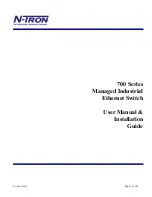
49
48
Ext. Port
Enter the number of the external port used by the server in the
Ext.
Port
column. Check with the Internet application documentation for more
information.
TCP or UDP
Select the protocol
UDP
or
TCP
for each application. You can-
not select both protocols.
Int. Port
Enter the number of the internal port used by the server in the
Int.
Port
column. Check with the Internet application software documentation for
more information.
IP Address
Enter the IP address of the server that you want the Internet users
to be able to access. To find the IP address, go to “Appendix D: Finding the
MAC Address and IP Address for Your Ethernet Adapter.”
Enabled
Check the
Enabled
box to enable the service you have defined. UPnP
Forwarding will not function if the
Enable
button is left unchecked. This is dis-
abled (unchecked) by default.
When finished making your changes on this tab, click the
Save Settings
button
to save these changes, or click the
Cancel Changes
button to undo your
changes. For further help on this tab, click the
Help
button.
Telnet
A terminal emulation protocol commonly used on Internet and TCP/IP-
based networks. It allows a user at a terminal or computer to log onto a remote
device and run a program.
SMTP
(Simple Mail Transfer Protocol) The standard e-mail protocol on the
Internet. It is a TCP/IP protocol that defines the message format and the mes-
sage transfer agent (MTA), which stores and forwards the mail.
DNS
(Domain Name System) The way that Internet domain names are locat-
ed and translated into IP addresses. A domain name is a meaningful and easy-
to-remember “handle” for an Internet address.
TFTP
(Trivial File Transfer Protocol) A version of the TCP/IP FTP protocol
that has no directory or password capability.
Finger
A UNIX command widely used on the Internet to find out information
about a particular user, such as a telephone number, whether the user is cur-
rently logged on, and the last time the user was logged on. The person being
“fingered” must have placed his or her profile on the system in order for the
information to be available. Fingering requires entering the full user@domain
address.
HTTP
(HyperText Transport Protocol) The communications protocol used to
connect to servers on the World Wide Web. Its primary function is to establish
a connection with a web server and transmit HTML pages to the client web
browser.
POP3
(Post Office Protocol 3) A standard mail server commonly used on the
Internet. It provides a message store that holds incoming e-mail until users log
on and download it. POP3 is a simple system with little selectivity. All pending
messages and attachments are downloaded at the same time. POP3 uses the
SMTP messaging protocol.
NNTP
(Network News Transfer Protocol) The protocol used to connect to
Usenet groups on the Internet. Usenet newsreaders support the NNTP protocol.
SNMP
(Simple Network Management Protocol) A widely used network mon-
itoring and control protocol. Data is passed from SNMP agents, which are
hardware and/or software processes reporting activity in each network device
(hub, router, bridge, etc.) to the workstation console used to oversee the net-
work. The agents return information contained in a MIB (Management
Information Base), which is a data structure that defines what is obtainable
from the device and what can be controlled (turned off, on, etc.).
















































